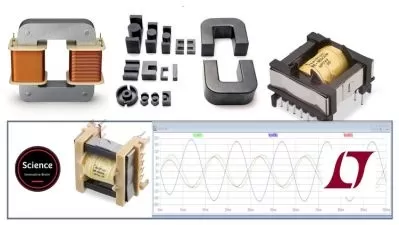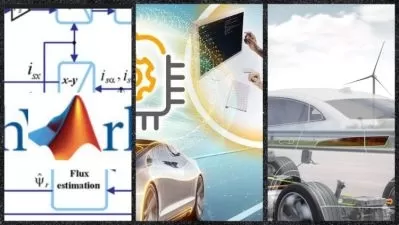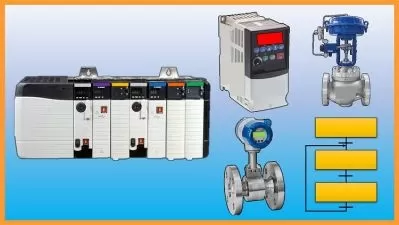Electronics - Basics and Advanced
VPACHKAWADE Research Center
9:04:59
Description
Components, Circuits, Analysis, Design, Testing and Troubleshooting
What You'll Learn?
- Learn about electronic components, their symbols, and functions within circuits
- Develop skills in designing and prototyping electronic circuits on breadboards and troubleshooting circuit designs
- Gain proficiency in analyzing electronic components and circuits using fundamental laws and techniques
- The course will cover electronics components and semiconductor devices and their applications
- Learn practical electronics - do it yourself practice
- Learn basics and advances of electronic components, semiconductor devices (diode, bjt, mosfet, op-amp, etc)
- Learn how to use software (CAD) to design, simulate and analyse circuits
- Learn details on diode, diode circuits, KVL, KCL, transistor and transistor circuits, biasing methods, etc.
Who is this for?
What You Need to Know?
More details
DescriptionNew topics added :
Voltage regulators
Amplifiers as comparators
Op-Amp Half-Wave Rectifier_ Design, Simulation, and Analysis with SPICE
Are you eager to understand the world of electronics? Whether you're an aspiring engineer, a tech enthusiast, or someone simply curious about how the gadgets you use every day work, our "Basic Electronics - Crash Course" is your ticket to understanding the fundamental principles that power the modern world.
Course Highlights:
Foundations of Electronics: Dive into the very core of electronics by exploring concepts like voltage, current, resistance, capacitance and power. Understand Ohm's law and how it governs the behavior of electronic components.
Electronic Components: Discover the key building blocks of electronic circuits, including resistors, capacitors, inductors, diodes, and transistors. Learn how to identify, use, and connect these components effectively.
Circuit Analysis: Master the art of analyzing simple electronic circuits. You'll develop the skills to calculate voltages, currents, and power across different components using various circuit analysis techniques. Learn details on KVL and KCL with examples.
Basic Circuit Design: Start designing your circuits! Explore different types of circuits such as voltage dividers, regulators, amplifiers, and filters. Get hands-on experience designing and building your own basic circuits.
Semiconductor Devices: Uncover the magic of semiconductors. Learn about diodes and transistors, their types, functions, and applications in modern electronics. Learn details on diode, diode circuits, transistor and transistor circuits, biasing methods, etc.
Digital Electronics: Enter the world of digital logic gates and binary arithmetic. Understand how digital circuits form the backbone of computers and modern technology.
Practical Applications: Discover how basic electronics concepts apply to real-world applications. From simple gadgets to complex systems, you'll see how electronics is everywhere.
Troubleshooting and Repair: Equip yourself with essential troubleshooting skills to identify and fix common electronic problems. Learn how to use multimeters and oscilloscopes effectively.
Safety in Electronics: Safety is paramount when working with electronics. We'll cover best practices for safely handling electronic components and equipment.
Who this course is for:
- This course is intended for beginners and enthusiasts who want to learn about basic electronics.
- Undergraduate students in engineering, science and technology in all disciplines
- Electronics hobbyists
- Engineers and technicians
- Anyone curious about how electronics work and how to use and apply it to develop practical applications.
- Whether you have a background in electronics or are completely new to the subject, this course will provide a solid foundation and practical knowledge to start working with electronics and undertake exciting projects.
- Professionals willing to revise the concepts in electronic components, semiconductor devices and circuits analysis
New topics added :
Voltage regulators
Amplifiers as comparators
Op-Amp Half-Wave Rectifier_ Design, Simulation, and Analysis with SPICE
Are you eager to understand the world of electronics? Whether you're an aspiring engineer, a tech enthusiast, or someone simply curious about how the gadgets you use every day work, our "Basic Electronics - Crash Course" is your ticket to understanding the fundamental principles that power the modern world.
Course Highlights:
Foundations of Electronics: Dive into the very core of electronics by exploring concepts like voltage, current, resistance, capacitance and power. Understand Ohm's law and how it governs the behavior of electronic components.
Electronic Components: Discover the key building blocks of electronic circuits, including resistors, capacitors, inductors, diodes, and transistors. Learn how to identify, use, and connect these components effectively.
Circuit Analysis: Master the art of analyzing simple electronic circuits. You'll develop the skills to calculate voltages, currents, and power across different components using various circuit analysis techniques. Learn details on KVL and KCL with examples.
Basic Circuit Design: Start designing your circuits! Explore different types of circuits such as voltage dividers, regulators, amplifiers, and filters. Get hands-on experience designing and building your own basic circuits.
Semiconductor Devices: Uncover the magic of semiconductors. Learn about diodes and transistors, their types, functions, and applications in modern electronics. Learn details on diode, diode circuits, transistor and transistor circuits, biasing methods, etc.
Digital Electronics: Enter the world of digital logic gates and binary arithmetic. Understand how digital circuits form the backbone of computers and modern technology.
Practical Applications: Discover how basic electronics concepts apply to real-world applications. From simple gadgets to complex systems, you'll see how electronics is everywhere.
Troubleshooting and Repair: Equip yourself with essential troubleshooting skills to identify and fix common electronic problems. Learn how to use multimeters and oscilloscopes effectively.
Safety in Electronics: Safety is paramount when working with electronics. We'll cover best practices for safely handling electronic components and equipment.
Who this course is for:
- This course is intended for beginners and enthusiasts who want to learn about basic electronics.
- Undergraduate students in engineering, science and technology in all disciplines
- Electronics hobbyists
- Engineers and technicians
- Anyone curious about how electronics work and how to use and apply it to develop practical applications.
- Whether you have a background in electronics or are completely new to the subject, this course will provide a solid foundation and practical knowledge to start working with electronics and undertake exciting projects.
- Professionals willing to revise the concepts in electronic components, semiconductor devices and circuits analysis
User Reviews
Rating
VPACHKAWADE Research Center
Instructor's Courses
Udemy
View courses Udemy- language english
- Training sessions 100
- duration 9:04:59
- Release Date 2023/12/16











